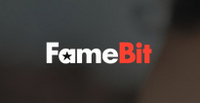Monday, March 16, 2015
FameBit: Connecting Brands With YouTubers

It's a new world out there for content creators on YouTube, who are now able to create their own--often substantial--following. But, how do you pay for that content and creativity? Los Angeles-based FameBit (www.famebit.com) has developed a new platform which lets any content creator connect with brands, without the need for an agency or MCN, to help them grow their content and network. We spoke with co-founder David Kierzkowski and Agnes Kozera about the company, and how its technology and marketplace is enabling growth for both YouTubers and brands.
Tell us about FameBit?

David Kierzkowski: We're the first, and the leading marketplace that connects YouTubers to brands for product and service endorsements. Agnes had developed a subscription service a year and a half ago, and wanted to try to connect with some YouTubers to promote that service on YouTube. But, she found that it was a very tedious and manual process to do that. You had to go to YouTube, figure out who the top ranking YouTubers where, and find them. There was no real easy process to do it. So, we got together, and thought--why not create a marketplace that reverses that process. On our marketplace, a brand can sign up in thirty seconds, and request video endorsements, which goes out to the dashboard of YouTubers. If a YouTuber wants to endorse a brand, they send over their proposals. ON the brand side, what happens is they receive between 100 to 200 proposals within seven days, at at that time, we reverse the process and the brand decides which YouTubers will fit the profile of the brand, based on demographics, age range, video quality, and so on. Once they decide which YouTubers to hire, they can fund that video production. Those funds are held in escrow, so it's safe for both sides. We operate a workroom, where they can collaborate on that video, and where brands can decide when they are going to publish to YouTube or request edits. We have a 98 percent approval rate on our platform.
How long have you been working on this?
David Kierzkowski: We launched into beta in January of 2015, and launched to the public in May. It's been going great. We recently crossed over the 300 million subscriber range. It took MCNs years to do that, and it took us seven months. We did over $3M last year in gross revenue, and we now have over 8,000 creators on our platform, with over 10,000 branded videos.
That's quite a bit of growth, how did you manage that many videos already?
Agnes Kozera: Self service enabled us to grow very quickly. Unlike agencies and MCNs, who work with YouTubers through a sales force, we use technology to do that. That's the huge difference between us and other services who focus on YouTube marketing at this stage. We don't just support one campaign, we do hundreds of videos. We really focus on democratizing content production, and connecting brands to those smaller creators. We tell those brands, it's great to have one viral video, but you can achieve a lot more reach and content with SEO value, if you work with lots of smaller creators. And, you can do that at a fraction of the cost, doing that through us.
David Kierzkowski: Think of it like AdSense, where brands come in monthly to continuously deploy these YouTube marketing campaigns. We're able to give them reach, to creators who speak the brand's voice. We believe that's very exciting. Before, using the MCN model, which is very agency like, they only focused on the top 5 and maybe top 10 percentof their talent, with only massive brands like Coca Cola. The other 90 percent of their creators really were like counters for their network. X and Y MCN would claim they had 50,000 content creators, but really they were only servicing 100 at best. On our platform, everyone can and does earn money, earning everything from $50 to $10,000 on our platform.
Agnes Kozera: As far and brands go, preior to us, they had either navigated the manual process on YouTube, or they wen to MCNs. However, those MCNs really only deal with larger talent and so they have pretty high starting budgets. They don't really service smaller brands. I think we're kind of the first to help smaller brands leverage this kind of service.
How big of a following do YouTubers need to use your platform?
Agnes Kozera: YouTubers on our platform start at 1,000 subscribers to get on Famebit, and at that level they will start earning money. They will earn everywhere from $100 to $20,000 on a video and higher, depending on the brand and what they're willing to pay.
David Kierzkowski: Our YouTubers have 48,000 subscribers on average, normally, and those content creators are charging between $250 to $500. That allows brands, who might only have $5,000 to try on YouTube influence marketing, to have 10 to 15 videos. As a marketer, that means you can see what types of video work for you, whether it's a dedicated video or favorite video, you can see if you like a YouTuber and their marketing, and you can double down on what works. That's compared to blowing $5,000 or $10,000 which may or may not work, on just one YouTuber. You're only able to achieve that, in a large, organized way, on a platform like ours.
From your perspective, can YouTubers make this a full time job yet?
Agnes Kozera: We get lots of emails from content creators, on how this has changed things for them, and allows them to focus on creating content and making music on YouTube full time, because they can earn this extra income, and don't need that part time job or whatever they've been doing. We're definitely moving towards that. It all depends on how engaged the YouTubers are, how dedicated to earning money they are. The sky's the limit. There are opportunities on Famebit, brands signing up daily, and it's just a matter of how many proposals they submit and how persistent they are. We're definitely getting there, where YouTubers can have the ability to work as freelancers and create their own content, and not have to go through an agency.
Where are brands on the idea of YouTube today?
David Kierzkowski: I think that, with any marketplace or new industry, education is a key piece. A year ago, it was a challenge to convince people that YouTube marketing was very powerful, and that they should leverage it. However, since we have such a low entry point, there is really no barrier. You can try a YouTuber for $100, or $200, and see how it works, and double down. You don't need to go to a MCN with $100,000 and blow your yearly budget on ads. You can come here with an experimental budget, and come and try YouTube marketing yourself.
Agnes Kozera: I think this is most exciting for smaller brands, who get direct communications with content creators on the platform. Those brands can accept a proposal, and have control over communications, talking points, and the creative. Brands really like to have that say, and ownership over content, without having to work through a third party in the middle. Brands are really happy with the results, which is why we have such a high rate of approvals, because they have ownership of that content.
What kind of content and brands does this seem to be working with best?
Agnes Kozera: There is not any one. There are different purposes for the content and marketing. Overall, what is really important for brands to do, is really try and test different creative objectives to see what works for them. There is no cookie cutter approach to YouTube marketing. For example, even with fashion brands, where we are working with multiple brands, we see for one that lookbooks do really well, but for another dedicated reviews work very well. You have to test and that's what we do, we test it and replicate it at scale for brands.
David Kierzkowski: Our goal is to have every brands to convert some of their budget into YouTube marketing spend, whether that's $500 or $5000. As this market continues to grow, and video becomes more and more popular, it's an exciting time for us.
Thanks!